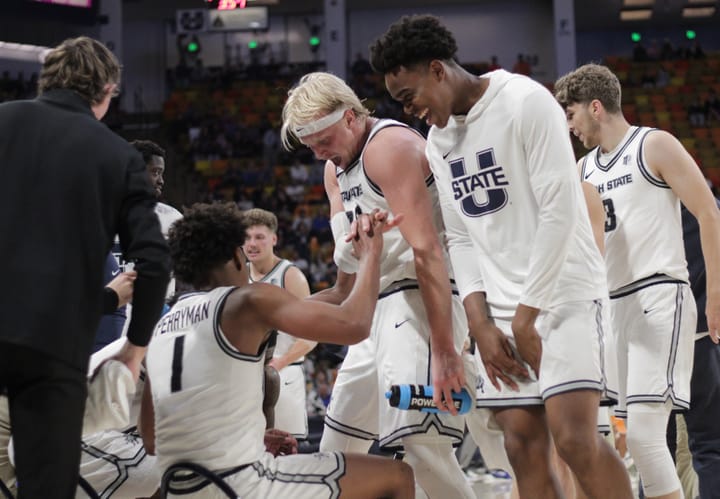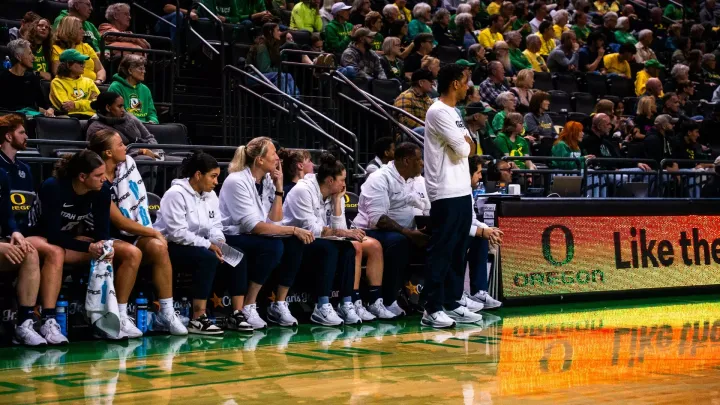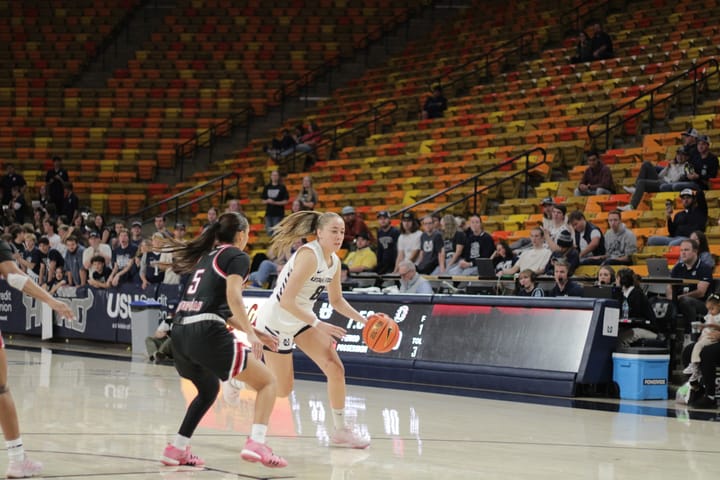Night With The Pros Headlines Jerrod Calhoun's Fundraising Push
(Free feature) I spoke with Jerrod Calhoun this offseason about his vision for where Utah State basketball is headed. It was on full display in Wednesday's Night with the Pros:
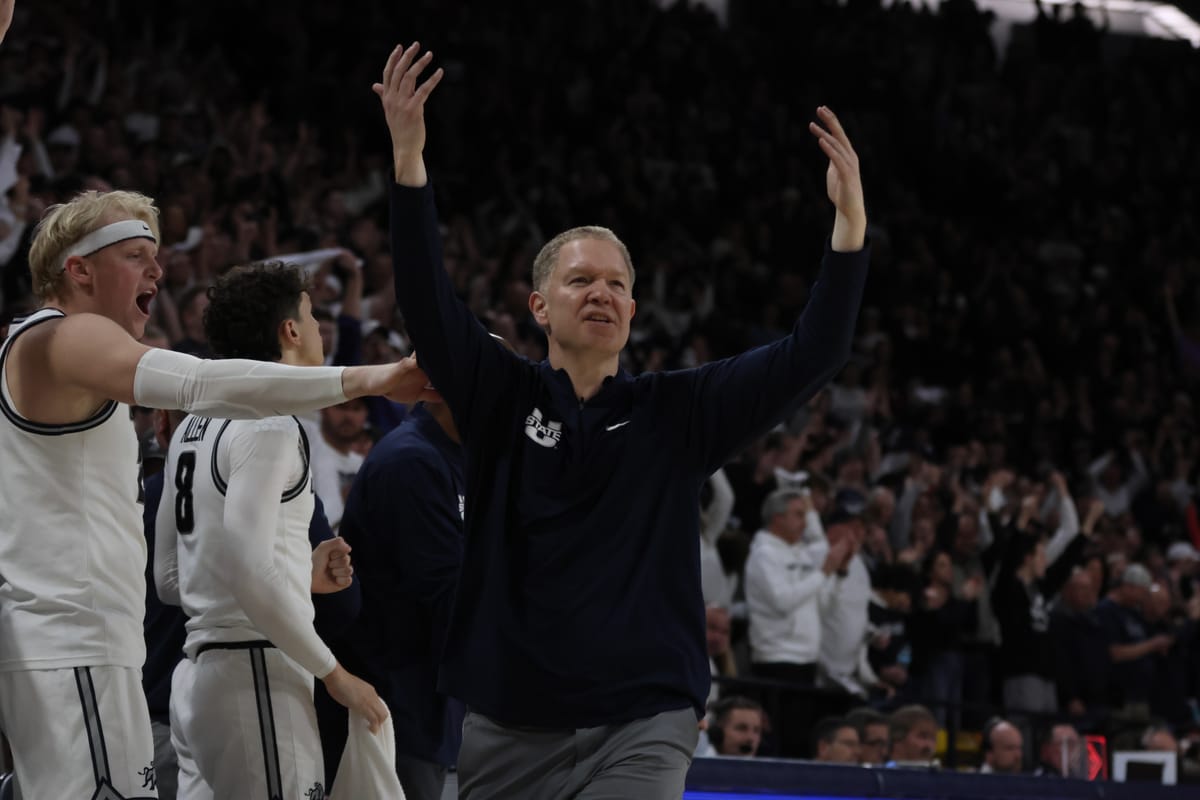
Many college coaches, no matter their sport, view fundraising as a chore. It comes with far greater stakes than you'd find washing the dishes or mowing the lawn, but it's a chore all the same – something you simply have to do. You can't run a collegiate program without funds, and you can't have funds without dressing up, putting on a smile and shaking some hands every now and again.
Utah State's Jerrod Calhoun does not appear to see it that way. Calhoun on the fundraising trail is often Calhoun at his most ambitious. It's a responsibility of his role he can control, free from the randomness inherent to a game built around a bouncy orange ball and the whims of supremely talented young men – the best of whom are still, ultimately, bound to bouts of wild variability. The 43-year-old head coach can draw up an offensive set with the best of them in college basketball and takes great pride in that. However, success on that front still depends on five players executing in unison while five others do whatever they can to stop them.
There are no such constraints in the world of fundraising. As long as it's both feasible and compliant with NCAA regulations, Calhoun can bring any idea to life exactly as he envisions it. For a man with no shortage of ideas and a fierce competitive streak informing almost all of them, it's easy to see the appeal of the craft. He applied it in his first head coaching job at Fairmont State, inheriting an 8-19 team and converting it into an ascendant power at the DII level that went 34-3 and fell 10 points short of a national title in his fifth and final season.
He did the same with a Youngstown State program that hadn't enjoyed a 20-win season in two decades when he took over ahead of the 2017-18 campaign. Calhoun spearheaded efforts to repeatedly renovate YSU's Beeghly Center, capped with a $2 million project to replace seats that had sat unchanged since the building opened in 1972. When he wasn't working on facilities upgrades, he was pushing Youngstown State's NIL efforts toward the top of the Horizon League. His track record as a fundraiser played no small part in Utah State's decision to hire him as Danny Sprinkle's replacement last spring.
While the Aggies prepare for their second campaign under his direction and their last before departing the Mountain West for a new-look Pac-12, that part of Calhoun's skill set will feature prominently.
“The brands are what made (the Pac-12),” Calhoun told The Aggship in an interview conducted at the end of July. “These brands now are going to take on a life of their own. You have to be very creative in the way you market your program, the way you talk about your program and the way you sell it. We're selling a totally different style of play compared to the Mountain West, it'll be two different strategies.
"We have to adjust with that. We have to be strategic not only with our presentations to these recruits, but with our department in how we go about selling this new league. To me, the way we've sold it is that it will be one of the best basketball leagues in America. Any time you're going up against Mark Few in Gonzaga, probably the most consistent program in the country over the last 20 years on the West Coast, you have a great league.”
Of course, the same could be said at essentially any point of Calhoun's first 17 months on the job. He made several direct references to fundraising at his introductory press conference in April of 2024, involved himself consistently in Utah State's Reach and Rise campaign, and played a massive part in building support for the Blue A Collective. The growth of the latter is already apparent on Calhoun's 2025-26 roster. Headlined by junior guard Mason Falslev, who Calhoun estimates will be a "top-four player financially" in the Mountain West this season, the Aggies have tripled their budget compared to the 2024-25 campaign – which still netted 26 wins and an NCAA tournament berth.
“There are great opportunities to take the next step in our fundraising,” Calhoun said. “When you have consistency with your staff, you can build consistent relationships even outside the players, so we've got to get the next forward steps in the process of trying to be one of the top teams in our conference.
“I think we did that this offseason. We went from one of the lowest-budgeted at-large teams in the country, if not the lowest budgeted at-large team. There are teams from the Big Ten and different power conferences that spent three, four or five times the amount of money as us and didn't make the NCAA tournament. I don't think that's been talked enough about, and we have now tripled what we're going to spend from last year. That's certainly the help of Jim Laub and Eric Laub, the Laub family has led that charge, but there's been a ton of community involvement from a lot of people who stepped up this offseason.”
Calhoun is optimistic, and at least a little proud, when he talks through the success Utah State enjoyed in retaining and bolstering its talent this past spring. The Aggies suffered only one unexpected departure – guard Deyton Albury, who jumped to New Mexico for a full-time starting role and a hefty payday – and largely won the battles they needed to win.
They fought off deep-pocketed suitors for Falslev, the homegrown star central to everything the program intends to do this season. They kept fellow rising junior Tucker Anderson and Karson Templin in town and held onto both of Albury's incumbent counterparts at point guard, senior Drake Allen and sophomore Jordy Barnes. A five-man freshman class that Calhoun touted as akin to striking gold arrived on campus this offseason without issue. And still, Utah State had enough left over to sign up a robust, experienced batch of transfers. Vanderbilt guard MJ Collins, Utah center Zach Keller and Butler guard Kolby King all claim extensive power conference experience, forward Garry Clark was a two-time first-team all-Southland player for Texas A&M-Corpus Christi, and winger Luke Kearney was a major bright spot within the MWC at Air Force.
It's a team the second-year head coach feels can contend well into March, and one that came about as a direct result of the massive budgetary bump his program has received. While it wasn't the lone reason, the local buy-in and community support for Aggie basketball played a role in retaining the man at the helm, too, snapping what had been a frustrating streak of coaching departures.
“I can't answer for those other coaches, I can only answer for myself,” Calhoun said. “I, for the first time, feel like we can win and really win big in March. We were unable to do that (last year). It left a very bitter taste in my mouth, the way we finished, not only in the NCAA tournament but also at the end of the season. I want to be on a total mission, and I think our players are on a mission to make sure that not only do we get off to a good start, but we take that next step.”
There's always a new horizon in collegiate athletics, though, particularly in this era of near-constant upheaval. When I sat down with Calhoun at the end of July, his focus had already shifted fully to Utah State's next set of hurdles. The Aggies need a new president and athletic director – which Calhoun is "antsy" about, frequently making his way back to Utah State's need for leadership that understands the financial imperatives of that forthcoming move to the Pac-12. They have a new recruitment and retention fund that allows for direct contribution to Utah State's revenue-sharing model. Calhoun and his wife, Sarah, had already donated $150,000 at the time of that interview, two days before the fund was publicly announced.
The questions of outreach and revenue generation have followed Calhoun throughout the offseason. Tried and true events like golf outings and donor banquets remain in the rotation, but he wants to expand Utah State's efforts to bring more supporters in, which has been a struggle in recent years with constant turnover among both coaches and administrators.
“Today, I donated $150,000 to our retention fund,” Calhoun said. “I think now I'm the second- or third-biggest donor in that fund to retain athletes, and it's my goal to not only be good for our sport. I want all the sports to win championships because I think it just adds so much excitement to the community and to your campus. I think with my commitment and my wife's commitment, we wanted to put our money where our mouth was.
"I want there to be more access to our program. I want to do more open practices. I want to do more meet and greets. That's what this program, to me, has been missing, because so many coaches have had success and left. Where we can build a real program, I think, is by doing some of those things.”
In the Spectrum on Wednesday evening, Calhoun put his vision for Utah State's path forward on display in an event so well-tailored to the head coach's ethos that it nearly feels too obvious. Equal parts community involvement, alumni outreach and recruiting pitch, all baked into a single fundraiser, Utah State's Night with the Pros is Calhoun incarnate.
The Aggies welcomed home as many of their star pupils (more than 40, all told) as chief of staff Paul Molinari could fit into an evening that included a meet-and-greet, dinner, a live auction, and a Q&A with the event's headliners: Program legends Sam Merrill and Neemias Queta, both of whom have found long-term homes in the NBA – the latter with the Boston Celtics under Calhoun's longtime friend and former assistant Joe Mazzulla, also featured prominently on the night's marquee and in the much-touted Q&A. It was, as Calhoun put it, an event for everything.
“Every year at Youngstown State we always brought in a headline name, and what we wanted to do was generate revenue to help our program,” Calhoun said. “We felt like this was a no-brainer. Paul Molinari, my chief of staff, has done an exceptional job reaching out to various people in the community to make sure there was interest. So, once we gauged everybody's interest, we thought this would be a home run. We have to be more creative in how we’re bringing in different people with different events. You can get stale with the number of events you do. Back in the day, it was golf outings and more golf outings. Those things get a little bit redundant. We want this to be an experience like no other."
“I think it's for everything. It's community involvement. It's definitely for the retention fund, to get the dollars in there. That's really, really important. And then, I think it's for the people who we're bringing back. We're bringing back Sam and Neemi, and Sam's already been to practice. We have to bring people together. Sports brings us all together, so to bring them into the Spectrum and hear the stories will be really, really neat. We did this for a number of years at Youngstown, and every year it got bigger and bigger, and then more people talked about it and they wanted to come. Once we sell out the tables, I think there's going to be a real possibility where we sell single tickets [note: Utah State did indeed sell out the tables, and put single tickets on offer in late August]. We've got to sell the tables first, that's going to be really important, and then we want to get all of our fans into the Spectrum and pack the place.”
It's apparent in conversation with Calhoun that the outing is as much a cohesive blueprint as it was a standalone event. He often speaks of building sustainably, in a way that suits the strengths of the program and the interests of the community it serves. Cash grabs and gimmicks go over like a lead balloon in Cache Valley. It's a fanbase that takes basketball very seriously, that holds deep reverence for players, coaches and teams past, and that expects to see Utah State's history honored and respected by its present representatives.
For Calhoun, a history buff in his own right who frequently sells recruits and transfers on their professional prospects within his systems, squaring that circle requires no real stretch. It's a time of major change in Logan, one of the greatest Utah State has seen athletically, and the Aggies must meet the moment to keep pace with myriad prolific, well-supported schools. If the program can brighten its future by better embracing its past, offering some needed stability amid a rapidly shifting landscape, that's a win-win Calhoun and Co. simply cannot afford to pass up.
“Anytime we have professional athletes who have put on the Aggie uniform, we have to go above and beyond to honor these individuals,” Calhoun said. “They're at the highest level of our sport. Do you know how hard it is to not only play in one NBA game, but make a roster? Now, these guys are making a name for themselves in the NBA. I'm enamored by that. I love talking to Sam and I can't wait to meet Neemi. Paul flew out and spent some time with Joe and got a chance to meet Neemi. I think it'll be a home run event, and all the money that we raise that night will go back into our retention fund.
“We're going to create an environment out here in Logan where we want to honor anybody who has worn the Aggie uniform. So, we're bringing former players back. They'll be spread out in the crowd with different tables, and we have to continue to build on that. I think certain coaches have put more time into it. I want to spend a lot of time in it, whether it's through our mentorship program or our character class. When we get our new AD hired, I want to bring back certain teams to honor them at the games, and we have to do more and more of that. We need to do a really good job at this one, and then we have to keep having events like this.”
